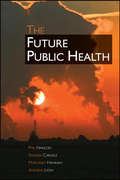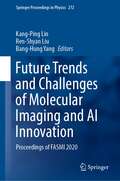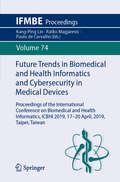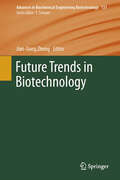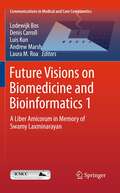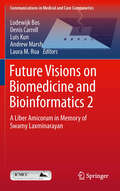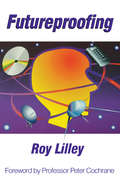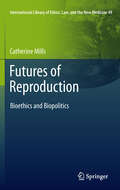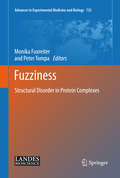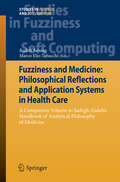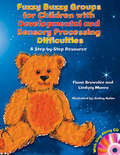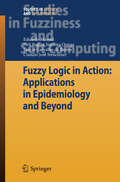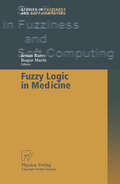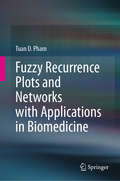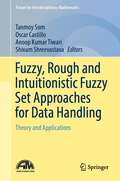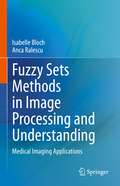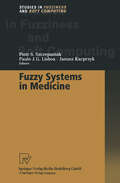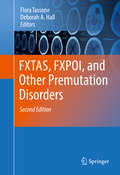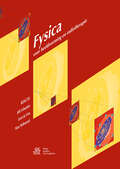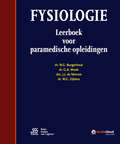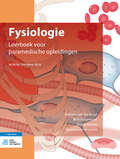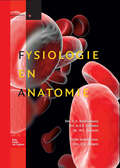- Table View
- List View
The Future Public Health (UK Higher Education OUP Humanities & Social Sciences Health & Social Welfare)
by Phil Hanlon Sandra Carlisle Andrew Lyon Margaret HannahObesity, depression, addiction, loss of wellbeing: these are issues which sap the resources and spirit of modern practitioners. Public health is being challenged by the existence of an 'ingenuity gap' – the gap between an interacting kaleidoscope of problems and our capacity to respond effectively. This innovative text bridges the gap between current public health values and skills and those required to tackle future challenges. The authors introduce the key models and theories of public health, as well as the factors that have shaped its history and development. The book also: Establishes the links between current public health problems and emerging threats like global warming and resource depletionExplores the true nature of modern and emerging threats to healthCreates a new model for the ‘future public health’ Explores what these changes will mean for the future public health practitionerThis is a book which sets out the reasons why we need a fundamentally new approach to public health and explores how this might be achieved.The Future Public Health is informed by a six year research project, commissioned by the Scottish Government, to trace the development of our current situation and look for solutions to the challenges facing public health. Visit the AfterNow website (www.afternow.co.uk) to access an array of resources including:Introductory videos12 Audio podcasts Over 30 short papers and essays
Future Trends and Challenges of Molecular Imaging and AI Innovation: Proceedings of FASMI 2020 (Springer Proceedings in Physics #272)
by Kang-Ping Lin Ren-Shyan Liu Bang-Hung YangThis volumes presents the proceedings of the FASMI 2020 conference, held at Taipei Veterans General Hospital on November 20-22, 2020. It presents contributions on all aspects of molecular imaging, discovered by leading academic scientists and researchers. It also provides a premier interdisciplinary treatment of recent innovations, trend, and concerns as well as practical challenges and solutions in Molecular Imaging and put an emphasis on Artificial Intelligence applied to Imaging Data. FASMI is the annual meeting of the Federation of Asian Societies for Molecular Imaging
Future Trends in Biomedical and Health Informatics and Cybersecurity in Medical Devices: Proceedings of the International Conference on Biomedical and Health Informatics, ICBHI 2019, 17-20 April 2019, Taipei, Taiwan (IFMBE Proceedings #74)
by Kang-Ping Lin Ratko Magjarevic Paulo De CarvalhoThis book gathers the proceedings of the IV International Conference on Biomedical and Health Informatics (ICBHI 2019), held on 17-20 April, 2019, in Taipei, Taiwan. Contributions span a range of topics, including medical imaging, biosignal processing, biodata management and analytics, public and personalized health systems, mobile health applications and many more. The IV conference edition gave a special emphasis to cybersecurity issues and cutting-edge medical devices, as it is reflected in this book, which provides academics and professionals with extensive knowledge on and a timely snapshot of cutting-edge research and developments in the field of biomedical and health informatics.
Future Trends in Biotechnology (Advances in Biochemical Engineering/Biotechnology #131)
by Jian-Jiang ZhongSystems Metabolic Engineering: The Creation of Microbial Cell Factories by Rational Metabolic Design and Evolution, by Chikara Furusawa, Takaaki Horinouchi, Takashi Hirasawa, Hiroshi Shimizu Impacts of Quorum Sensing on Microbial Metabolism and Human Health, by Yang-Chun Yong, Jian-Jiang Zhong CHO Glycosylation Mutants as Potential Host Cells to Produce Therapeutic Proteins with Enhanced Efficacy, by Peiqing Zhang, Kah Fai Chan, Ryan Haryadi, Muriel Bardor, Zhiwei Song Cell-Free Biosystems for Biomanufacturing, by Chun You, Y.-H. Percival Zhang Lipid Bilayer Membrane Arrays: Fabrication and Applications, by Xiaojun Han, Guodong Qi, Xingtao Xu, Lei Wang RNA Aptamers: A Review of Recent Trends and Applications, by Kyung-Nam Kang, Yoon-Sik Lee
Future Visions on Biomedicine and Bioinformatics 1: A Liber Amicorum in Memory of Swamy Laxminarayan (Communications in Medical and Care Compunetics #1)
by Lodewijk Bos, Denis Carroll, Luis Kun, Andrew Marsh and Laura M. RoaSwamy Laxminarayan was an outstanding researcher active in many diverse fields of science and technology. This liber amicorum in memory of Swamy Laxminarayan collects Medical and Biological Engineering and Informatics contributions to the Safety and Security of Individuals and Society. The authors are renowned scientists and the aim of their writing is to recall the enormous personal and scientific achievement of Swamy Laxminarayan.
Future Visions on Biomedicine and Bioinformatics 2: A Liber Amicorum in Memory of Swamy Laxminarayan (Communications in Medical and Care Compunetics #2)
by Lodewijk Bos, Denis Carroll, Luis Kun, Andrew Marsh and Laura M. RoaSwamy Laxminarayan was an outstanding researcher active in many diverse fields of science and technology. He was one of the most prominent biomedical scientists and his ideas influenced the Biomedical Technology substantially. This book tries to provide an overview on the multiple achievements of Swamy Laxminarayan. It presents a collection of his most outstanding publications and an overview on his outstanding life. This Volume is the second part of the liber amicorum in Memory of Swamy Laxminarayan.
Futureproofing: If You Can Imagine it, it Will Happen, If You Can't - You're Out of it
by Roy Lilley Peter CochraneIf you can imagine it it will happen...if you can't you're out of it! This book is a white-knuckle ride. It drills down into what we are doing now and comes up in the future to see what comes next. The book is a commentary and a clarion call and an invitation to see round corners and a clarion call to respond to what's there. Roy Lilley has been speaking on Futureproofing around the world throughout the 'nineties. His aim has been to awaken managers entrepreneurs and anyone who will listen to the fact that the world is changing. Faster and faster like a spiral fundamentally and structurally leaving behand those who are unprepared. Thousands of people are now meeting the challenges Futureproofing presents. You decide - keep up or give up. If you have heard Roy Lilley speak on Futureproofing you will want this book ...if you have not yet heard him read it first.
Futureproofing: If You Can Imagine it, it Will Happen, If You Can't - You're Out of it
by Roy Lilley Peter CochraneIf you can imagine it it will happen...if you can't you're out of it! This book is a white-knuckle ride. It drills down into what we are doing now and comes up in the future to see what comes next. The book is a commentary and a clarion call and an invitation to see round corners and a clarion call to respond to what's there. Roy Lilley has been speaking on Futureproofing around the world throughout the 'nineties. His aim has been to awaken managers entrepreneurs and anyone who will listen to the fact that the world is changing. Faster and faster like a spiral fundamentally and structurally leaving behand those who are unprepared. Thousands of people are now meeting the challenges Futureproofing presents. You decide - keep up or give up. If you have heard Roy Lilley speak on Futureproofing you will want this book ...if you have not yet heard him read it first.
Futures of Reproduction: Bioethics and Biopolitics (International Library of Ethics, Law, and the New Medicine #49)
by Catherine MillsIssues in reproductive ethics, such as the capacity of parents to ‘choose children’, present challenges to philosophical ideas of freedom, responsibility and harm. This book responds to these challenges by proposing a new framework for thinking about the ethics of reproduction that emphasizes the ways that social norms affect decisions about who is born. The book provides clear and thorough discussions of some of the dominant problems in reproductive ethics - human enhancement and the notion of the normal, reproductive liberty and procreative beneficence, the principle of harm and discrimination against disability - while also proposing new ways of addressing these. The author draws upon the work of Michel Foucault, especially his discussions of biopolitics and norms, and later work on ethics, alongside feminist theorists of embodiment to argue for a new bioethics that is responsive to social norms, human vulnerability and the relational context of freedom and responsibility. This is done through compelling discussions of new technologies and practices, including the debate on liberal eugenics and human enhancement, the deliberate selection of disabilities, PGD and obstetric ultrasound.
Fuzziness: Structural Disorder in Protein Complexes (Advances in Experimental Medicine and Biology #725)
by Monika Fuxreiter Peter TompaDetailed characterization of fuzzy interactions will be of central importance for understanding the diverse biological functions of intrinsically disordered proteins in complex eukaryotic signaling networks. In this volume, Peter Tompa and Monika Fuxreiter have assembled a series of papers that address the issue of fuzziness in molecular interactions. These papers provide a broad overview of the phenomenon of fuzziness and provide compelling examples of the central role played by fuzzy interactions in regulation of cellular signaling processes and in viral infectivity. These contributions summarize the current state of knowledge in this new field and will undoubtedly stimulate future research that will further advance our understanding of fuzziness and its role in biomolecular interactions.
Fuzziness and Medicine: A Companion Volume to Sadegh-Zadeh’s Handbook of Analytical Philosophy of Medicine (Studies in Fuzziness and Soft Computing #302)
by Rudolf Seising Marco Elio TabacchiThis book is a collection of contributions written by philosophers and scientists active in different fields, such as mathematics, logics, social sciences, computer sciences and linguistics. They comment on and discuss various parts of and subjects and propositions introduced in the Handbook of Analytical Philosophy of Medicine from Kadem Sadegh-Zadeh, published by Springer in 2012. This volume reports on the fruitful exchange and debate that arose in the fuzzy community upon the publication of the Handbook. This was not only very much appreciated by the community but also seen as a critical starting point for beginning a new discussion. The results of this discussion, which involved many different perspectives from science and the humanities and was warmly encouraged by Kadem Sadegh-Zadeh himself, are accurately reported in this volume, which is intended to be a critical companion to Kadem Sadegh-Zadeh´s handbook. Rudolf Seising is currently an adjunct researcher at the European Centre for Soft Computing in Mieres, Asturias (Spain) and a college lecturer at the Faculty of History and Arts, at the Ludwig Maximilians University of Munich (Germany). Marco Elio Tabacchi is currently the Scientific Director of the Italian National Research & Survey Organization Demopolis, and a research assistant in the Soft Computing Group at University of Palermo (Italy).
Fuzzy and Rough Techniques in Medical Diagnosis and Medication (Studies in Fuzziness and Soft Computing #212)
by Elisabeth Rakus-AnderssonIn the late eighties of the twentieth century I encountered a paper referring to mathematics dealing with imprecision applied to medical diagnosis. I was working in the area of medical statistics at that time, and obviously I was interested in the contents of the paper. After I had read it I became fascinated by new possibilities of medical data interpretation and processing proposed by the author. The new world of fuzziness, originated by Professor Lotfi Zadeh, seemed to open up to me and I started reading all accessible material about fuzzy set theory. Many years have passed since then. We are now living in the information so- ety and we do not experience troubles in reaching scientific material. Lately I have read many papers and books about treating medical tasks solved by using fuzzy ideas. I am still keen on tracing applications in medicine, and by myself I have been contributing to some concepts in this subject that has motivated me to p- pare my own book. The objective of writing such a book has been a little parti- lar, namely, I have intended to present the subject of fuzzy tools and techniques in medicine for eventual users. These, maybe representatives of medical or phar- cological staffs, are not expected to possess a large amount of mathematical knowledge.
Fuzzy Buzzy Groups for Children with Developmental and Sensory Processing Difficulties: A Step-by-Step Resource
by Aisling Nolan Fiona Brownlee Lindsay MunroChildren with sensory and cognitive difficulties can struggle to interact with their peers, be easily distracted, and have problems coping with change. Fuzzy Buzzy Groups for Children with Developmental and Sensory Processing Difficulties has been devised to address the needs of children with sensory processing difficulties and development delay in specialist and inclusive settings. This easy-to-follow resource will enable professionals to engage with children in a relaxed and fun way that explores sensory experiences. It contains everything you need to run a Fuzzy Buzzy group: from advice for choosing sensory food and drink and criteria for selecting suitable children, to tips for involving parents in the group and sourcing sensory materials. The authors guide you step-by-step through how to carry out a session, and include photocopiable forms and checklists as well as a sing-along CD containing music to use with the group. This resource will help children not just to explore sensory experiences, but also to learn to share, take turns, listen, interact with their peers and improve their self-esteem. The eight-session programme is ideally suited to children aged 2-5, although this can be adapted to suit individual needs, and is perfect for early years' practitioners, teachers, teaching assistants, family respite carers and other professionals working with young children.
Fuzzy Buzzy Groups for Children with Developmental and Sensory Processing Difficulties: A Step-by-Step Resource (PDF)
by Aisling Nolan Fiona Brownlee Lindsay MunroChildren with sensory and cognitive difficulties can struggle to interact with their peers, be easily distracted, and have problems coping with change. Fuzzy Buzzy Groups for Children with Developmental and Sensory Processing Difficulties has been devised to address the needs of children with sensory processing difficulties and development delay in specialist and inclusive settings. This easy-to-follow resource will enable professionals to engage with children in a relaxed and fun way that explores sensory experiences. It contains everything you need to run a Fuzzy Buzzy group: from advice for choosing sensory food and drink and criteria for selecting suitable children, to tips for involving parents in the group and sourcing sensory materials. The authors guide you step-by-step through how to carry out a session, and include photocopiable forms and checklists as well as a sing-along CD containing music to use with the group. This resource will help children not just to explore sensory experiences, but also to learn to share, take turns, listen, interact with their peers and improve their self-esteem. The eight-session programme is ideally suited to children aged 2-5, although this can be adapted to suit individual needs, and is perfect for early years' practitioners, teachers, teaching assistants, family respite carers and other professionals working with young children.
Fuzzy Logic in Action: Applications in Epidemiology and Beyond (Studies in Fuzziness and Soft Computing #232)
by Eduardo Massad Neli Regina Ortega Laecio Carvalho de Barros Claudio J. StruchinerFuzzy Logic in Action: Applications in Epidemiology and Beyond, co-authored by Eduardo Massad, Neli Ortega, Laécio Barros, and Cláudio Struchiner is a remarkable achievement. The book brings a major paradigm shift to medical sciences exploring the use of fuzzy sets in epidemiology and medical diagnosis arena. The volume addresses the most significant topics in the broad areas of epidemiology, mathematical modeling and uncertainty, embodying them within the framework of fuzzy set and dynamic systems theory. Written by leading contributors to the area of epidemiology, medical informatics and mathematics, the book combines a very lucid and authoritative exposition of the fundamentals of fuzzy sets with an insightful use of the fundamentals in the area of epidemiology and diagnosis. The content is clearly illustrated by numerous illustrative examples and several real world applications. Based on their profound knowledge of epidemiology and mathematical modeling, and on their keen understanding of the role played by uncertainty and fuzzy sets, the authors provide insights into the connections between biological phenomena and dynamic systems as a mean to predict, diagnose, and prescribe actions. An example is the use of Bellman-Zadeh fuzzy decision making approach to develop a vaccination strategy to manage measles epidemics in São Paulo. The book offers a comprehensive, systematic, fully updated and self- contained treatise of fuzzy sets in epidemiology and diagnosis. Its content covers material of vital interest to students, researchers and practitioners and is suitable both as a textbook and as a reference. The authors present new results of their own in most of the chapters. In doing so, they reflect the trend to view fuzzy sets, probability theory and statistics as an association of complementary and synergetic modeling methodologies.
Fuzzy Logic in Medicine (Studies in Fuzziness and Soft Computing #83)
by Senen Barro Roque MarinTo say that Fuzzy Logic in Medicine, or FLM for short, is an important addi tion to the literature of fuzzy logic and its applications, is an understatement. Edited by two prominent informaticians, Professors S. Barro and R. Marin, it is one of the first books in its field. Between its covers, FLM presents authoritative expositions of a wide spectrum of medical and biological ap plications of fuzzy logic, ranging from image classification and diagnostics to anaesthesia control and risk assessment of heart diseases. As the editors note in the preface, recognition of the relevance of fuzzy set theory and fuzzy logic to biological and medical systems has a long history. In this context, particularly worthy of note is the pioneering work of Profes sor Klaus Peter Adlassnig of the University of Vienna School of Medicine. However, it is only within the past decade that we began to see an accelerat ing growth in the visibility and importance of publications falling under the rubric of fuzzy logic in medicine and biology -a leading example of which is the Journal of the Biomedical Fuzzy Systems Association in Japan. Why did it take so long for this to happen? First, a bit of history.
Fuzzy Recurrence Plots and Networks with Applications in Biomedicine
by Tuan D. PhamThis book presents an original combination of three well-known methodological approaches for nonlinear data analysis: recurrence, networks, and fuzzy logic.After basic concepts of these three approaches are introduced, this book presents recently developed methods known as fuzzy recurrence plots and fuzzy recurrence networks. Computer programs written in MATLAB, which implement the basic algorithms, are included to facilitate the understanding of the developed ideas. Several applications of these techniques to biomedical problems, ranging from cancer and neurodegenerative disease to depression, are illustrated to show the potential of fuzzy recurrence methods. This book opens a new door to theorists in complex systems science as well as specialists in medicine, biology, engineering, physics, computer science, geosciences, and social economics to address issues in experimental nonlinear signal and data processing.
Fuzzy, Rough and Intuitionistic Fuzzy Set Approaches for Data Handling: Theory and Applications (Forum for Interdisciplinary Mathematics)
by Tanmoy Som Oscar Castillo Anoop Kumar Tiwari Shivam ShreevastavaThis book facilitates both the theoretical background and applications of fuzzy, intuitionistic fuzzy and rough, fuzzy rough sets in the area of data science. This book provides various individual, soft computing, optimization and hybridization techniques of fuzzy and intuitionistic fuzzy sets with rough sets and their applications including data handling and that of type-2 fuzzy systems. Machine learning techniques are effectively implemented to solve a diversity of problems in pattern recognition, data mining and bioinformatics. To handle different nature of problems, including uncertainty, the book highlights the theory and recent developments on uncertainty, fuzzy systems, feature extraction, text categorization, multiscale modeling, soft computing, machine learning, deep learning, SMOTE, data handling, decision making, Diophantine fuzzy soft set, data envelopment analysis, centrally measures, social networks, Volterra–Fredholm integro-differential equation, Caputo fractional derivative, interval optimization, decision making, classification problems. This book is predominantly envisioned for researchers and students of data science, medical scientists and professional engineers.
Fuzzy Sets Methods in Image Processing and Understanding: Medical Imaging Applications
by Isabelle Bloch Anca RalescuThis book provides a thorough overview of recent methods using higher level information (object or scene level) for advanced tasks such as image understanding along with their applications to medical images. Advanced methods for fuzzy image processing and understanding are presented, including fuzzy spatial objects, geometry and topology, mathematical morphology, machine learning, verbal descriptions of image content, fusion, spatial relations, and structural representations. For each methodological aspect covered, illustrations from the medical imaging domain are provided. This is an ideal book for graduate students and researchers in the field of medical image processing.
Fuzzy Systems in Medicine (Studies in Fuzziness and Soft Computing #41)
by Piotr S. Szczepaniak Paulo J. G. LisboaProvides an introduction to the fundamental concepts of fuzziness together with a compilation of recent advances in the application to medicine. The tutorials in the first part of the book range from basic concepts through theoretical frameworks to rule simplification through data clustering methodologies and the design of multivariate rule bases through self-learning by mapping fuzzy systems onto neural network structures. The case studies which follow are representative of the wide range of applications currently pursued in relation to medicine. The majority of applications presented in this book are about bridging the gap between low-level sensor measurements and intermediate or high-level data representations. The book offers a comprehensive perspective from leading authorities world-wide and provides a tantalising glimpse into the role of sophisticated knowledge engineering methods in shaping the landscape of medical technology in the future.
FXTAS, FXPOI, and Other Premutation Disorders
by Flora Tassone Deborah A. HallThis book should serve as a resource for professionals in all fields regarding diagnosis, management, and counseling of patients with FXTAS, FXPOI and their families, as well as presenting the molecular basis for disease that may lead to the identification of new markers to predict disease risk and eventually lead to target treatments.The book will present information on all aspects of FXTAS, FXPOI and other premutation disorders including clinical features and current supportive management, radiological, psychological, and pathological findings, genotype-phenotype relationships, animal models and basic molecular mechanisms. Genetic counseling issues are also discussed.
Fysica voor beeldvorming en radiotherapie
by Jelle Scheurleer, Geert Vries and Hans WelleweerdFysica voor beeldvorming en radiotherapie maakt deel uit van de serie Leerboeken voor radiologisch laboranten. Deze serie leerboeken was oorspronkelijk een gezamenlijk project van de Raad Beroepsopleiding Radiologisch Laboranten (BRL), de Vereniging van Opleidingsinstituten voor Radiologisch laboranten (VORL) en Elsevier gezondheidszorg. Thans is deze samenwerking uitgebreid met de MBRT-opleidingen binnen het Hoger Gezondheidszorg Onderwijs. Fysica voor beeldvorming en radiotherapie is de geactualiseerde druk van Stralingsfysica. De stralingsfysica houdt zich bezig met de fysische aspecten van zowel straling als radioactiviteit. Straling is al lang niet meer het enige fysische medium dat wordt gebruikt voor medische beeldvorming. Al geruime tijd is echografie een veelgebruikte modaliteit en met name MRI heeft zich de afgelopen jaren in sterke mate ontwikkeld. Dit boek begint met een hoofdstuk over de bouw van de materie. Daarna komen elektriciteit en magnetisme en elektromagnetisme aan de orde. Vervolgens worden de processen die optreden bij de interactie tussen straling en materie, beschreven en het kwantificeren van de stralingsdosis (dosimetrie). Een inleiding op het verschijnsel radioactiviteit behandelt enige praktische toepassingen hiervan. Omdat MRI en echografie zich de laatste jaren sterk hebben ontwikkeld, zijn de hoofdstukken Elektriciteit en Magnetisme, Optica en Trillingen en geluid toegevoegd.Fysica voor beeldvorming en radiotherapie is behalve voor radiodiagnostisch en radiotherapeutisch laboranten in opleiding en MBRT-studenten ook bij uitstek geschikt voor hen die reeds de (initiële) opleiding hebben afgesloten. De uitgave vormt eveneens een goede introductie voor radiologen, al dan niet in opleiding.
Fysiologie: Leerboek voor paramedische opleidingen
by W.G. Burgerhout G.A. Mook J.J. de Morree W.G. ZijlstraVoor een adequate uitvoering van behandelingen, patiëntenvoorlichting en communicatie met andere (para)medische disciplineszijn kennis en inzicht betreffende het functioneren van het menselijk lichaam voor de fysiotherapeut zonder meer basisvoorwaarden, en dit geldt eveneens voor de oefentherapeut en de bewegingstechnoloog. Fysiologie, hét leerboek voor de paramedische opleidingen, is daarom een noodzakelijk en welkom onderdeel van het curriculum.De fysiotherapeut houdt zich voornamelijk bezig met stroornissen van het bewegingsapparaat, de bloedsomloop en de ademhaling. De fysiologie daarvan wordt in dit boek uitgebreid behandeld. Omdat de fysiotherapeut steeds meer betrokken is bij revalidatie, sport en specifieke aandoeningen bij kinderen en ouderen, wordt extra aandacht besteed aan de fysiologie van inspanning, groei en veroudering.De indeling van Fysiologie is gebaseerd op het onderscheiden van functies, niet van structuren. Ter wille van de overzichtelijkheid zijn de hoofdstukken ondergebracht in drie secties: Principes, Functies van het zenuwstelsel en Lichaamsfuncties. Het boek sluit aan bij het kennisniveau en de ervaringswereld van de eerstejaars student. De stof wordt ondersteund door tekeningen, schema's en tabellen, en wordt regelmatig onderbroken door intermezzi: teksten waarin dieper op een belangrijk aspect wordt ingegaan, of waarin een fysiologisch princiepe met een voorbeeld uit de praktijk wordt geïllustreerd.
Fysiologie: Leerboek voor paramedische opleidingen
by Marieke van der Burgt Wim Burgerhout Jeroen Alessie Annemieke HouwinkDit boek geeft paramedische studenten op een toegankelijke manier basiskennis over de gehele fysiologie. Het accent ligt daarbij op de fysiologie van het bewegingsapparaat, de bloedsomloop en de ademhaling. Fysiologie sluit aan bij het kennisniveau van eerstejaars studenten. Bij het boek hoort een website met animaties die de stof verhelderen en verbanden leggen met de praktijk. Fysiologie behandelt eerst de algemene fysiologische principes en gaat daarna in op structuren en functies van het zenuwstelsel. De laatste hoofdstukken gaan over lichaamsfuncties. In de twee bijlagen worden tot slot scheikundige en natuurkundige begrippen beschreven en worden eenheden, symbolen en afkortingen verklaard. In de praktijk spelen fysiotherapeuten een belangrijke rol bij bijvoorbeeld sport en revalidatie. Daarom zijn in deze druk de hoofdstukken over de fysiologie van het zenuwstelsel en de fysiologie van inspanning, groei en veroudering uitgebreid. Het boek is voor deze druk geheel herzien door een deels nieuw auteursteam.
Fysiologie en anatomie: Basiswerk V&V, niveau 5 (Basiswerken Verpleging en Verzorging)
by IJ. Jungen De Jong Consulting B.V. J.A.M. Kerstens E.M. Sesink H. Hendrikx C.A. Bastiaanssen A.A.F. Jochems M.J. Tervoort E.H.C. BastiaanssenVerpleegkundigen baseren hun handelen grotendeels op geneeskundige gegevens. Om deze gegevens juist te kunnen interpreteren, is een goede theoretische en praktische kennis van de fysiologie en anatomie nodig. Het basiswerk Fysiologie en anatomie geeft inzicht in de fysiologische en anatomische processen, en is een uitstekende basis om pathologische verschijnselen bij de patiënt te leren herkennen, interpreteren en hier adequaat op te reageren.Onder fysiologie verstaan we de wetenschap van de verrichtingen van het menselijk lichaam en de functies van de verschillende onderdelen. De anatomie houdt zich bezig met het bestuderen van de bouw van het menselijk lichaam. In dertien hoofdstukken komen de verschillende onderdelen van fysiologie en anatomie aan de orde. Van circulatie tot zenuwstelsel, van zintuigen tot voortplanting: Fysiologie en anatomie geeft een compleet overzicht. De stof is logisch ingedeeld en sluit uitstekend aan bij het handelen in de praktijk. Het boek is bovendien rijk geïllustreerd.Deze uitgave verschijnt in de serie Basiswerken en is erop gericht de student voldoende kennis en inzicht te geven om op professionele wijze het beroep van verpleegkundige uit te oefenen. De opbouw van de serie Basiswerken stimuleert het koppelen van eigen observaties en interpretaties aan medische kennis.
